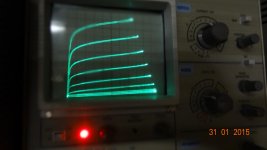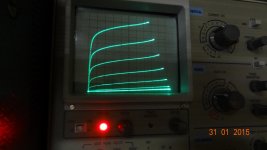Its called participation and I'm contributing where I can.
You sure are Richard, and I for one thank you for it. I have read your work for some decades now (I won't say how many, to protect us both from embarrassment) and I find your contributions here still up to your highest standards. There are some here who would distract us from our goals with fanciful stories, but you contribute real data tempered by years of knowledge and experience.
It pains me a bit to see two men I respect so much sniping at each other, but I am not going to presume to tell either you or Scott how to interact. I just keep listening to you both and trying to learn a bit.
This rings a bell, as I've been thinking of building one of those frequency-shifting bat detectors to listen to the bats that fly around the street light in front of the house every night. Same sort of thing.It may confuse naive viewers, but it helps some of us to "see" what we are looking at, even when it is not visible to the human eye.
What is the matter with you, Scott ?I can safely ignore these inputs and will.
its my way of saying same thing.... temp not at a standard temp nor controlled which it appears from casual tests, must be better controlled. Something for DIY to think about.
Interesting to me is that only 10Hz band is materially affected. Why is that?
By blowing on the device you apply a step function that is large enough
to change the operating point. And the spectrum of a step is?
Yes, lots at DC and nothing at 1 GHz.
If the step is very Heavisidish the spectrum will be very Diracish.
And 500pV/sqrt Hz for a small JFET...
If it sounds to be too good to be true - it usually is.
regards, Gerhard
Last edited:
BTW, these BF transistors were discussed at length on diyaudio.rs (loacl version) about two years ago, when one member (Sipi) who loves and knows FETs recommended them with several suggestions I now see here.
His main line was that this was a good and deserving replacement for 2SK170, which are available at a wild range of prices, they all come from China and are questionably (in view of Chinese practices) what they are purported to be, making purchases highly risky. The BF on the other hand is easily obtainable from Germany, which is a MUCH moe reliable source.
His main line was that this was a good and deserving replacement for 2SK170, which are available at a wild range of prices, they all come from China and are questionably (in view of Chinese practices) what they are purported to be, making purchases highly risky. The BF on the other hand is easily obtainable from Germany, which is a MUCH moe reliable source.
AFAIK there were no natural (real) color cameras on Hubble. Not much scientific info in color data from those types of filters (the nice picture type) mostly good PR generated by false coloring was done post facto (so I was told).
Hi Scott
I am not sure saying the Hubble doesn’t use a real color camera is fair.
CCD’s as used in optical cameras can be made to have a usable spectrum from near IR to just into UV.
A simple digital color camera has a black and white ccd sensor with a Bayer matrix of microscopic size color filters;
Bayer filter - Wikipedia, the free encyclopedia
But cameras used for space often use separate movable color filters which for the same number of camera pixels, gives about 4x the resolution.
Visually, zoomed in, a Bayer picture is a group of the three color dots, the other approach each pixel has a color.
For space if one is looking at Nebula and other ionized gasses, an improvement in signal to noise can be achieved by using filters that only pass those specific wavelengths such as those here for this purpose.
Note you can see through these and what color they are.
Astro-Physics Inc.
Now, since one is always using a B&W camera, that has taken several exposures with different filters, you can assign any color you want to for each frame when you stack them up to make “the picture”. And speaking of "the picture", with my set up, it wouldn't be unusual to stack 30 (or more) each, 15 to 60 second exposures with L, R G and B filters for a total of 120 exposures. This, like cooling the CCD is done for noise reduction.
Sometimes it is useful to use totally unrelated colors to make something more clear, sometimes seeing something just as it is fits the bill.
BTW, anyone who is out after dark this time of year can look up and see “this” below. To your unaided eye it looks like a glob of fuzz, the great nebula in Orion a breathtaking sight.
Here is a time exposure taken with both color and narrow band color filters. This is a nice picture for a ground based telescope, mine are not as nice but i still enjoy doing it.
The Orion Nebula Space Wallpaper
Hi Richard
If you have a can of freezmist handy, what happens when you cool down the DUT?
Best,
Tom Danley
Last edited:
Cheap modern digital cameras incorporate an IR filter in the light path.
Removal of the IR filter enables thermal photography.
Not quite a FLIR, but useful/fun never the less.
http://www.instructables.com/id/infrared-digital-camera---the-real-way/?ALLSTEPS
Dan.
Removal of the IR filter enables thermal photography.
Not quite a FLIR, but useful/fun never the less.
http://www.instructables.com/id/infrared-digital-camera---the-real-way/?ALLSTEPS
Dan.
Might be worth linking to this, "At the 2015 NAMM Show, Korg and Noritake introduced the Nutube, a new miniaturized and high performance vacuum tube", http://www.diyaudio.com/forums/tubes-valves/268852-new-tube-tech-korg.html, here - for future reference.
its my way of saying same thing.... temp not at a standard temp nor controlled which it appears from casual tests, must be better controlled. Something for DIY to think about.
Interesting to me is that only 10Hz band is materially affected. Why is that?
THx-RNMarsh
Richard, this indeed might be a shift in the DC operating point of the device. The die/package thermal mass on a SOT23 device is very small. Of course, I say this expecting that you used fine wires to attach the device to your test leads. Once a SOT23 devices is soldered down, the copper lands can be made large and the effect is reduced - this is of course also how the package dissipation can be improved.
If you have a curve tracer you may be able to verify this proposition independently.
In any event, for practical purposes, as long as the 1/f corner is below 100Hz and above that it's very low, I think it's good to go.
Cheap modern digital cameras incorporate an IR filter in the light path.
Removal of the IR filter enables thermal photography.
Not quite a FLIR, but useful/fun never the less.
http://www.instructables.com/id/infrared-digital-camera---the-real-way/?ALLSTEPS
Dan.
Can we use that for locating transistor heat-sink thermal hot spots and the like?
How does one remove the IR/UV coating on the camera lens safely?
THx-RNMarsh
Last edited:
BF Transistor: About 5 seconds between pictures..... normal room temp and freezed. Sorry I didnt use the scope camera -- just hand held camera... left the curve tracer sitting on the storage rack and set as per last use. step level shifts.
THx-RNMarsh
View attachment 462741
View attachment 462742
hey, you were talking about a "a modified version of Mr Wurcers X1000 amplifier",
AC-Couple that to the display
Maybe you should have used a blowtorch for the job
Carefully......Can we use that for locating transistor heat-sink thermal hot spots and the like?
How does one remove the IR/UV coating on the camera lens safely?
THx-RNMarsh
https://www.youtube.com/watch?v=BJq0GzmYALo
A thermal camera is much better as you get a calibrated reading, all you get with a DSRL is an indication of the hot spot. Used Thermal cameras a lot on designs over the years (Fluke), excellent tool for showing what's going on heat wise, and where hot spots may be, you also need some black electrical tape for the shiny components...
Now some may see the small SMD packages as being disadvantaged over older PTH packaging, this is not the case in many situations, what you get is a much lower thermal resistance between the die and the rest of the world, allowing you to control the temperature of the die much more closely... When mounted on a PCB. The packaging also has much less parasitic's from the board to the die, not so critical for Audio, but hi-speed and RF much better.
So this is not a problem, in-fact its an advantage when doing designs as said you can control the temperature of devices easier and in a more confined space. Just spent a few weeks re-designing some PCBs for thermal performance, lots of thermal vias, hybrid modules and 0705 Resistors.
A better test would be the DUT mounted on a PCB, we do device PCBs for a certain company that does Diodes etc. quite complex boards mechanically to fit in the test jig and hold the device down.
Last edited:
Just be aware that , like the removal of the anti-aliasing filter, it can change the accuracy of the reflex view finder. So better to reserve-it to an EVF cameras.How does one remove the IR/UV coating on the camera lens safely?
Nb: If i could use all my previous cameras to look at the IR diode of my remotes, and know if they are working, there is NO ir light at all hitting my Sony A7 censor.
Just be aware that , like the removal of the anti-aliasing filter, it can change the accuracy of the reflex view finder. So better to reserve-it to an EVF cameras.
Nb: If i could use all my previous cameras to look at the IR diode of my remotes, and know if they are working, there is NO ir light at all hitting my Sony A7 censor.
I'll give that a try with my new DSLR, my older stuff especially picks up the IR transmitters perfectly...
There are some people removing the colour filters to create a B&W only camera, even more delicate an operation.
- Status
- Not open for further replies.
- Home
- Member Areas
- The Lounge
- John Curl's Blowtorch preamplifier part II

